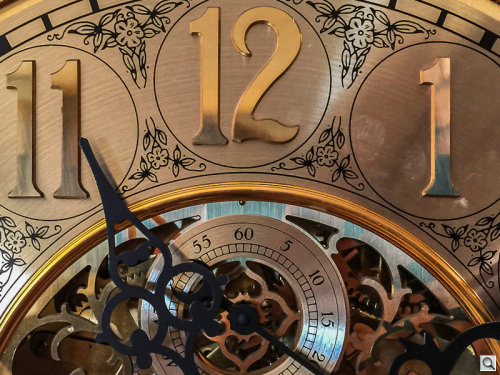Photo Corners headlinesarchivemikepasini.com
![]()
A S C R A P B O O K O F S O L U T I O N S F O R T H E P H O T O G R A P H E R
![]()
Enhancing the enjoyment of taking pictures with news that matters, features that entertain and images that delight. Published frequently.
Friday Slide Show: The Grandfather Clock



3 January 2020
In 1992 Mom and Dad bought themselves a grandfather clock. They went to a shop in Benecia, Calif., that specialized in them and ordered the Sligh you see in today's slide show. It has been running in the entry hall ever since.
For the last year or so, we've been winding the thing on our visits with Mom. It's one less thing for her to worry about.
A few months ago we thought we'd take a few snapshots of it with our iPhone 6 Plus. Because, you know, why should it escape our lens.
It was tough. There's no light in the entry way, which is great for the wood but not much help for shutter speeds.
We might have worked a little harder at it but these were just snapshots. Which is the photographic equivalent of sketches. We could come back later, armed with what we learned from these, to take more studied images.
We did come back later, of course, but we never got around to reshooting the clock. Time has a way of fleeing.
It fled for the Sligh Furniture Company, which quit making clocks early in this century before going out of business entirely.
When we wind the clock, we get the key from inside the door on the left side. And there we can see the mechanics, which are surprisingly like our mantel clock. Just a brass box with gears to make things happen.
You can upset the thing setting the time if you don't know how to do it. Turning backwards is preferred because you don't have to stop for the chimes.
And godforbid you get the daylight and night time 12-hour sequence confused or the silencer will quiet the chimes in the day and ring them all through the night.
Grandfather clocks are fun that way.
Don't ask about the cycles of the moon. We haven't made peace with that yet. It involves pressing the disk in, which sounds dangerous.
Meanwhile, it just keeps ticking, quite accurately and chiming on the quarter hours with a nice concert now and then. The church up the corner from us could learn a thing or two from that clock.
Chimes must be the attraction of grandfather (and grandmother) clocks (not to mention mantel clocks) because these days we have more convenient ways of telling time. Like, "Hey, Google! What time is it?"
One of our more amusing images on this theme of time was taken years and years ago when we visited Santa Barbara Cemetery, which sits on a bluff by the zoo. The chapel there proclaims itself the Sanctuary of Life Eternal in nice black, iron letters with a note below in smaller iron letters adding, "Visitors Welcome" with a helpful arrow toward the entrance. Eternity is apparently only for visitors.

Visitors Welcome. OpticFilm 135 scan of Kodak color negative shot with Nikon FM2 (detail). Unidentified visitors.
In our wandering through the grave sites, we came across a gravestone chiseled with a particularly enchanting phrase we never forgot. "Until the day breaks and the shadows flee away," it said.
We have since learned that is from the Song of Solomon (4:6) in the Old Testament where it was used to encourage living life fully. In the context of a grave, though, it seems to promise reunion at the end of time.
Ah, time. We wind the clock, it ticks on, time flees.
